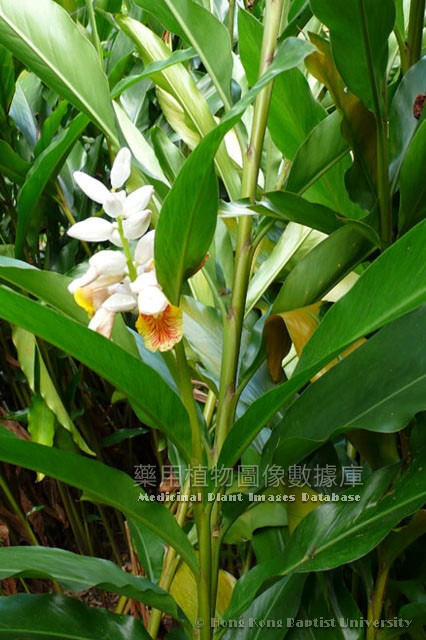|
Alpinia zerumbet (Pers.) Burtt. et Smith

|
English Name |
Shell Ginger, Beautiful Galangal, Shell-flower |
|
Latin name |
Alpinia zerumbet (Pers.) Burtt. et Smith |
|
Family & Genus |
Zingiberaceae, Alpinia |
|
Description |
Perennial evergreen herbs, 1.5-3m tall. Leaves large, alternate; leaves lanceolate, 30-60cm long, 5-10cm wide, apex acuminate, with convoluted small cusps, base gradually narrow, margin pubescent, glabrous on both sides; petioles 1-1.5cm long, ligules 0.5-1cm long, with hairs. Panicles raceme style, droopy, up to 30cm, rachis purple-red, pubescent, branches extremely small, each branches with 1-2(3) flowers. Small pedicels extremely small; bracteoles elliptic, 2-3.5cm long, white, top pink, flowers wrapped when buds, glabrous; small pedicels extremely small; calyx nearly campanulate, ca. 2cm long, white, top pink; corolla tube shorter than calyx, lobes oblong, ca. 3CM long, back 1 relatively large, milky, apex pink; pleurogenous degenerative stamens subulate, ca. 2mm long; labellum spoon-shaped-wide ovate, 4-cm long, apex crispate, yellow with purple-red colour; stamen ca. 2.5cm long; ovary golden coarse hairs; glands ca 2.5mm long. Capsules ovate, diameter ca. 2cm, sparsely coarse hairs, with exposed longitudinal strias, top with persistent calyx, vermilion when mature. Seeds with edges. Flowering: April –June, Fruiting: July to October. |
|
Distribution |
Growing near farmlands, fields, on roadsides and ravine tussock. Usually cultivated as ornamental trees around houses or in gardens. Distributed in Southwest Jiangsu, Southeast Zhejiang, Fujian, Taiwan, Hunan, Guangdong, Hong Kong, Hainan, Guangxi, Southwest Guizhou and Sichuan. The medicinal materials are mainly produced in Fujian, Guangdong, Guangxi, Guizhou and etc. |
|
Part Used |
Medical part: rhizome and fruits. Chinese name: Yanshanjiang. |
|
Harvest & Processing |
Root and stem: collected all over the year, used fresh or sliced, and sun-dried. Collected matured fruits and baked to dry. |
|
Chemistry |
Seeds contain cardamonin, alpinetin, borneol, merhyl cinnamate, camphor, sabinene, adixzedoariae, stigmasterol, stearic acid, arachidic acid, capsaicinoids, behenic acid, 1-tetracosanol and kalium chloratum, etc. |
|
Pharmacology |
Extracorporeal-frog-heart-inhibiting, isolated-guinea-pig-intestines-contracting, having no effect on toad abdominal muscle, but minor toxicity on mice. |
|
Properties & Actions |
Taste pungent, harsh, and warm in nature.Warming the middle for eliminating dampness, promoting qi-flowing for suppressing pains and interrupting malaria. |
|
Indications & Usage |
Used for cold and pain in the heart and abdomen, fullness of chest and abdomen, dyspepsia, vomiting and diarrhea, malaria.Oral administration: decocting, seeds or rhizome3-9g; Seeds powdered,1.5g each time. External application: appropriate amount, fresh rhizome smashed for application. |
|
Examples |
1. Gastralgia: shell ginger and trogopterus dung, 6g each. Grind into powders. Swallow 3g each time with warm boiled water.
2. Cellulitis: shell ginger rhizome 60g, fresh ginger 2 pieces, tomentose machilus leaf 0.3g. Pestle and apply onto lesions. |
|

